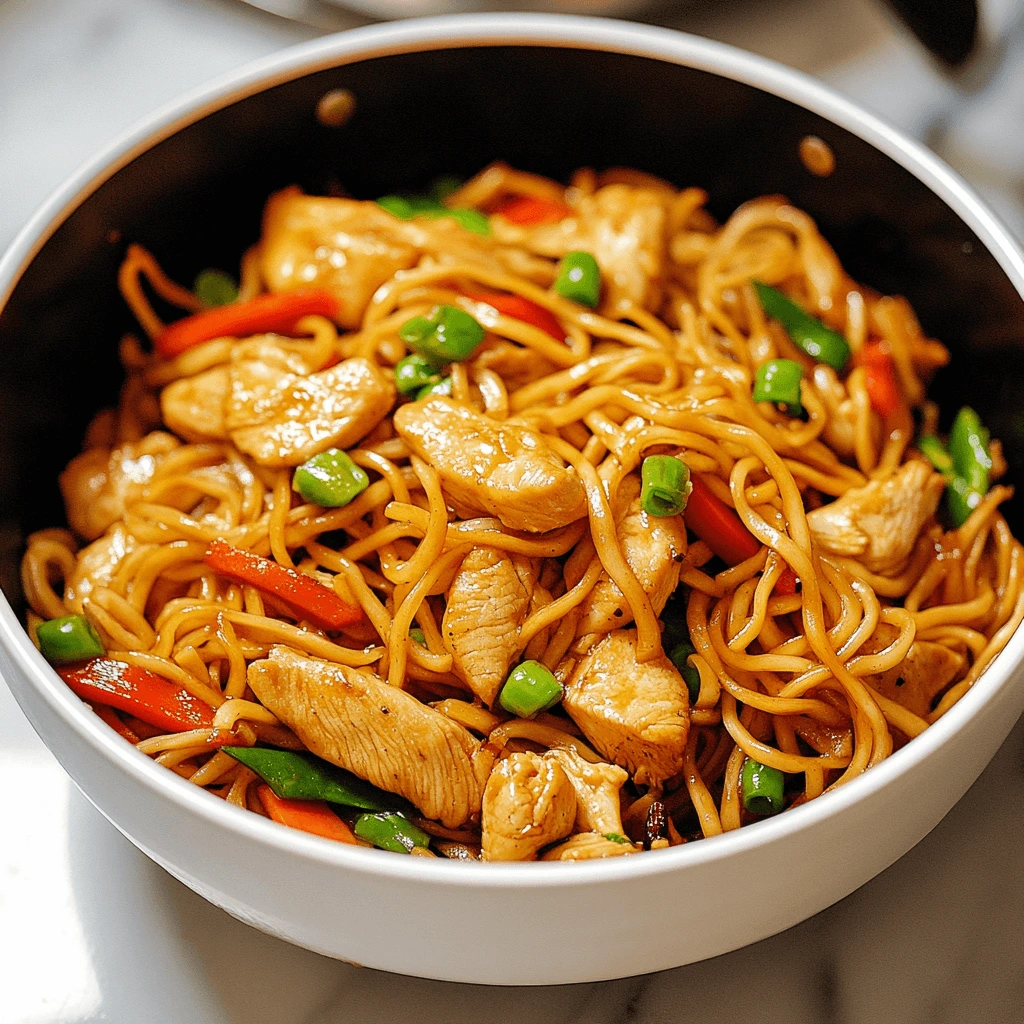Savor the satisfying blend of tender egg noodles, juicy chicken, crisp vegetables, and a savory sauce in this homemade chicken lo mein. Ready in under 30 minutes, it brings the flavors of your favorite takeout right to your kitchen.
Why You’ll Love This Recipe
This chicken lo mein is a one-pan wonder that’s both quick and customizable. Tender slices of marinated chicken combine with fresh egg noodles and colorful veggies in a silky sauce. It’s a family-friendly dish that’s easily adapted—swap proteins, add extra vegetables, or dial up the spice to suit your taste.
Ingredients
- 1 pound fresh lo mein egg noodles
- 8 oz. boneless skinless chicken thighs (or chicken breast, cut into thin strips)
- 2 teaspoons cornstarch
- 2 teaspoons water
- 2 teaspoons oil (plus more for cooking)
- 1 teaspoon oyster sauce
- 2 tablespoons hot water
- 1/8 teaspoon salt
- 1/8 teaspoon sugar
- 1 tablespoon light soy sauce
- 4 teaspoons dark soy sauce
- 1 teaspoon sesame oil
- 1/8 teaspoon white pepper
- 1 clove garlic (minced)
- 4 cups cabbage (shredded)
- 2 medium carrots (julienned—about 1 1/2 cups)
- 1 tablespoon shaoxing wine (or dry sherry cooking wine)
- 2 cups mung bean sprouts
- 2 scallions (julienned)
Directions

1. Bring a large pot of water to a rolling boil. Add the fresh lo mein egg noodles and stir gently to separate. Blanch for 45 seconds to 1 minute until just tender. Drain immediately and rinse under cold water to stop cooking. Set aside to drain thoroughly.
2. In a medium bowl, combine 2 teaspoons cornstarch, 2 teaspoons water, 2 teaspoons oil, 1 teaspoon oyster sauce, 2 tablespoons hot water, 1/8 teaspoon salt, 1/8 teaspoon sugar, and 1 tablespoon light soy sauce. Whisk until smooth. Add the chicken strips and toss to coat evenly. Let marinate at room temperature for 10–15 minutes.
3. While the chicken marinates, stir together 4 teaspoons dark soy sauce, 1 teaspoon sesame oil, 1/8 teaspoon white pepper, and 1 tablespoon shaoxing wine in a small bowl. Set this sauce mixture aside.
4. Heat a wok or large skillet over high heat until smoking lightly. Add 1–2 teaspoons oil and swirl to coat. Spread the marinated chicken in a single layer and sear, undisturbed, for 1–2 minutes until the underside is golden. Flip and stir-fry for another minute until just cooked through. Transfer the chicken to a plate.
5. Add a little more oil if needed. Toss in the minced garlic and stir for 10 seconds until fragrant. Add the shredded cabbage and julienned carrots. Stir-fry for about 1 minute until the vegetables begin to soften.
6. Return the chicken to the wok, then pour in the reserved dark soy/sesame oil/white pepper/shaoxing wine mixture. Stir to coat everything evenly.
7. Add the blanched noodles and 2 cups mung bean sprouts. Use tongs or two spatulas to toss and stir-fry for 1–2 minutes, ensuring the sauce coats all ingredients and the noodles are heated through.
8. Sprinkle the julienned scallions over the top, give one last toss, and remove from heat. Serve immediately.
Pro Tips and Variations
– Cut chicken into uniform strips so it cooks evenly and quickly.
– For an extra flavor boost, marinate the chicken up to 30 minutes in advance.
– Swap chicken for shrimp, pork, or extra-firm tofu for a different protein.
– Add mushrooms, bell peppers, or snow peas for more color and crunch.
– For gluten-free, use tamari in place of soy sauces and rice noodles instead of egg noodles.
Serving Suggestions
– Pair with hot-and-sour soup or egg drop soup for a full Chinese-style meal.
– Offer chili oil, soy sauce, or crushed red pepper on the side for guests to customize heat and saltiness.
– Serve alongside potstickers or vegetable spring rolls as an appetizer.
Storage/Reheating
– Store leftover lo mein in an airtight container in the refrigerator for up to 3 days.
– To reheat, stir-fry gently in a hot skillet with a splash of water or broth, or microwave with a damp paper towel covering to prevent drying out.
Notes
– Fresh lo mein egg noodles work best for texture; if using dried, cook per package instructions and rinse well.
– Adjust soy sauce levels based on your salt preference; taste and add more light or dark soy sauce as needed.
– This recipe scales easily—double the vegetables or protein to stretch servings.
FAQs
Can I use chicken breast instead of thighs?
Yes—you can substitute boneless, skinless chicken breast. Just slice thinly and watch cooking time so it doesn’t dry out.
My noodles stick together. How do I prevent that?
Rinse blanched noodles under cold water, then toss with a little oil before stir-frying. Work quickly in a very hot wok or skillet.
What’s the difference between light and dark soy sauce?
Light soy sauce is thinner and saltier; dark soy sauce is thicker, slightly sweeter, and adds color. Both are essential for authentic flavor and appearance.
Conclusion
chicken lo mein delivers rich, savory flavors, vibrant veggies, and satisfying noodles in every bite. With a simple marinade, speedy stir-fry technique, and endless customization options, it’s destined to become a weeknight favorite and a crowd-pleaser at any gathering. Enjoy!

